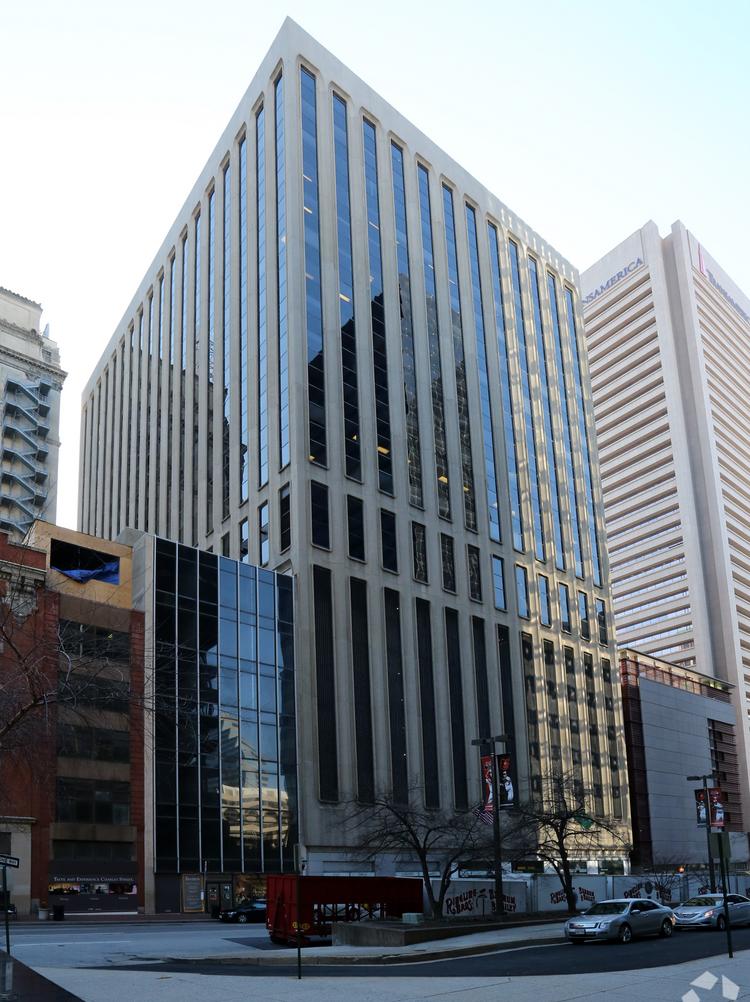Who vets hiring and recruitment in the Prince George’s County government?
Long before he became director of the Prince George’s County Department of Permitting, Inspections and Enforcement (DPIE), but while working for the county, Haitham Hijazi and his relatives were in business selling counterfeit Microsoft products.
Hijazi had already become chief of the county’s engineering services. In 1994, he was promoted to associate director of the Department of Public Works and Transportation’s office of engineering. In 1995, in federal court, Microsoft sued Hijazi, his wife, other relatives, and their companies engaged in selling Microsoft knock-offs, and won. See case linked here and here.
The lawsuit, titled Microsoft Corp. v. Grey Computer, et al., was filed December 21, 1995, in Baltimore (United States District Court, Southern District of Maryland). The published ruling can be found in LexisNexis. (910 F. Supp. 1077, Civ. A. No. AW 94-221.)
Plaintiff’s attorneys were Preston, Gates, now after mergers named K & L Gates.
The defendants were Grey Computer, Inc., owned and controlled by the Hijazis; Haitham Hijazi; his wife, Adieba Hijazi; Bilal Hijazi; Husim Hijazi; and Integrated Computers Electronic, Inc., another Maryland corporation owned and controlled by the Hijazi family.
The memorandum opinion by Judge Alexander Williams, Jr., lays out the case with laudable clarity:
Microsoft Corporation (“Microsoft”) instituted this civil action against Grey Computer, Inc. (“Grey”), Integrated Computer Electronic, Inc. (“ICE”), Intelligent Data Systems (“IDS”) and their respective principals.[1] Microsoft claims that Defendants infringed upon their copyrights and trademarks by selling or distributing counterfeit copies of Microsoft’s software products.
Before his appointment to the bench, Judge Williams had served as a States Attorney, a public defender, and a Juvenile Master in P. G. He became a federal judge the same year Haitham Hijazi became a public official in the P. G. County Office of Engineering.

Opening of DPIE
From the county press release announcing Hijazi’s appointment as director of the newly created DPIE:
Earlier in his government career, Dr. Hijazi served as the Associate Director of DPW&T’s Office of Engineering from July 1994 – October 2004; and, prior to that, he was the Chief of the Engineering Services Division within the Office of Engineering. Before joining Prince George’s County Government, Dr. Hijazi was the Chief Engineer and Operations Manager for Light, Elliot and Associates, a private engineering consulting firm located in Adelphi, Maryland.
Microsoft discovered the counterfeits:
On 31 January 1994, Microsoft commenced this action by filing its Complaint against Grey Computer, ICE and their respective principals, among others. In its original complaint Microsoft alleged copyright infringement, trademark infringement, false designation of origin and unfair competition arising out of the Defendants’ purported sale of counterfeit copies of Microsoft’s software products. On 1 February 1994, Microsoft personnel accompanied the U.S. Marshal Service as it executed a Writ of Seizure and Impound issued by this Court against Grey and ICE. Consequently, Microsoft obtained information indicating that Grey and ICE were involved in unauthorized distribution of counterfeit versions of Microsoft MS-DOS and Windows software products. Such information included a recently arrived shipment of approximately 1,000 units of alleged counterfeit Microsoft software products from Direct Wholesale. The information also included business records of Grey and ICE which confirmed that Direct Wholesale was the source of supply for the seized units of unauthorized Microsoft software products.
Microsoft then went farther back up the distribution pipeline:
On 2 February 1994, Microsoft filed its First Amended Complaint adding Direct Wholesale as a party defendant and obtained a Supplemental Writ of Seizure and Impound against Direct Wholesale. On 4 February 1994, the U.S. Marshal, accompanied by Microsoft’s attorneys, seized a box of eighteen diskettes containing Microsoft Windows software and along with various business records from Direct Wholesale. The records suggested that Direct Wholesale distributed counterfeit Microsoft software products nationally, as well as to Grey and ICE. The records, some of which were cryptically coded, also indicated that Direct Wholesale purchased and distributed unauthorized Microsoft software products in an unusual and suspicious manner. The seizures eventually revealed that Direct Wholesale purchased and distributed approximately 45,848 units of counterfeit Microsoft software products. Thereafter Microsoft filed another amended complaint adding Direct Wholesale’s sole shareholders and officers, Dewitt Williams and Timothy Mazoch, as party defendants.
Microsoft also won its amended case against the other individuals and another company involved in the production and sale of Microsoft knock-offs, moving for
summary judgment on issues of liability and damages against Direct Wholesale, Dewitt Williams and Timothy Mazoch (collectively “Defendants”). It also seeks a permanent injunction to prevent Defendants from further distributing, offering for sale or selling counterfeit computer software bearing Microsoft’s marks.
As Judge Williams summarized the two opposing positions in our adversarial court system,
Microsoft urges that this is a clear cut case of copyright and trademark infringement. Microsoft alleges Defendants distributed counterfeit goods, bearing Microsoft’s marks. Microsoft asserts that Defendants distributed poor quality copies of its copyrighted works and deceived consumers.
Defendants urge that they were innocent infringers. Williams and Mazoch posit that they conducted Direct Wholesale’s business according to the practices and procedures they learned while working as salesmen/brokers in the computer software field.
The Hijazis and their companies then sued their suppliers. They were able to settle out of court with Microsoft, but the unambiguous court’s ruling enjoined them from selling any more of the pseudo-Microsoft products.
Microsoft subsequently examined about 1,000 units of the seized software. The examination confirmed Microsoft’s suspicions that the software products were unauthorized and counterfeit reproductions of Microsoft software products. ICE and Grey, among others, filed crossclaims and a third-party complaint against Direct Wholesale. Microsoft settled its dispute with ICE, Grey, Adieba Hijazi, Bilal Hijazi, Hiatham Hijazi, Husim Hijazi, Intelligent Data Systems, Inc. and Nasser Faraj. Accordingly, the Court entered separate stipulated permanent injunctions against each of these defendants.
The recovered counterfeits were ordered turned over to Microsoft for destruction.
Based on information it gathered during the seizures and other relevant information, Microsoft moved for summary judgment against Direct Wholesale, Williams and Mazoch on its claims of copyright and trademark infringement, unauthorized distribution, false designation of origin and unfair competition. On 25 September 1995, the Court heard oral argument regarding Microsoft’s and ICE’s motions for summary judgment. Despite notice, Defendants chose not to attend the hearing. For the reasons set forth more fully below the Court will issue a written order granting Microsoft’s and ICE’s motions for summary judgment as to their third-party complaint. The Court will also grant Microsoft’s request for a permanent injunction and will order the impounded counterfeit software products delivered to Microsoft for destruction.
The case seems to have been relatively clear. The defendants did not dispute Microsoft’s ownership “of all of the software products at issue.”
Microsoft has provided the Court with evidence showing that the copyrights in all of the Microsoft products involved were registered with the United States Copyright Office in compliance with the Copyright Revision Act of 1976 and regulations flowing therefrom. See 17 U.S.C. § 101, et seq. Microsoft has valid Certificates of Registration for all of its software products. Moreover, it has been and still is the sole owner of all right, title and interest in, and to, the relevant copyrights and Certificates of Registration.
The defendants also did not dispute that “they were involved in copying Microsoft’s software products.”
Defendants Williams and Mazoch admit that from November 1993 through January 1994, ninety to ninety-five percent of their business involved the distribution of software products. While Williams and Mazoch claim that only eighty-five to ninety percent of their software sales involved the distribution of Microsoft software products, the invoices seized from Direct Wholesale indicate that nearly all of its business involved the distribution of counterfeit Microsoft software products during that time period.
Such arguments as the defendants did present were rejected by the court. For example,
Defendants argue that they did not intentionally copy Microsoft’s products. They posit that they had never seen and had no knowledge of Microsoft’s prerequisite licensing practices or of any of the limitations Microsoft imposed upon product distribution.
As the court wrote,
There is no dispute that Williams and Mazoch received the news releases regarding the sale of Microsoft’s software products and the restrictions. Williams and Mazoch are experienced computer software professionals with experience in the software industry dating back to 1989. They both had enough business savvy to engage in a successful, albeit, illegal business venture.
Regarding the thousands of computer products being distributed through ICE, the Hijazis’ company,
Finally, Defendants urge that Microsoft has only presented circumstantial evidence of copying. Defendants contend that there is no factual basis for Microsoft’s conclusion that the various units of software it examined “appeared identical” to Microsoft’s software products. They further contend that when Microsoft seized the software shipment from ICE, it had no way of knowing if the boxes had been previously opened or unsealed. Thus, according to Defendants, Microsoft had no way of knowing if the boxes had been tampered with after leaving Direct Wholesale.
This argument was also rebuffed by the court:
Microsoft counters that the facts of this case coupled with Defendants’ admissions clearly establish that the units shipped by Direct Wholesale and seized at ICE on 1 February 1994 were from Direct Wholesale and were counterfeit. Microsoft directs the Court’s attention to Williams’ statements that Direct Wholesale regularly shipped software products to ICE; that the products were normally shipped out of California; and, that prior to the seized shipment, Direct Wholesale had very little difficulty with ICE in terms of payment. (Williams Dep., p. 48-49).
The Court is satisfied that Microsoft has demonstrated that Defendants were engaged in copying Microsoft’s software products. “Copying can be shown by circumstantial evidence of access to the copyrighted work, and substantial similarity between the copyrighted work and the infringer’s work.” Johnson Controls, 886 F.2d at 1176) (citations omitted). Defendants do not dispute that they had access to Microsoft’s copyrighted work. Nor do they deny the substantial similarity between the seized software and Microsoft’s copyrighted work.
Moreover, nothing in the facts support Defendants’ conspiracy theory that some unidentified person or persons removed the units shipped from Direct Wholesale and replaced them with the seized units. The counterfeit software from Direct Wholesale was seized upon delivery. At no time did anyone other than the United States Marshal’s Service or the court-appointed custodian have possession, custody or control over the counterfeit Microsoft Software Products once they were delivered to ICE. This is self-serving conjecture on the part of Defendants and mere conjecture is not enough to create a genuine issue of material fact sufficient to withstand summary judgment. See Thompson Everett, Inc. v. National Cable Advertising, L.P.,57 F.3d 1317, 1323 (4th Cir.1995).
Indeed, the court found that the companies’ copyright infringement was extensive:
Moreover, Microsoft conducted a thorough examination of the business records seized from Direct Wholesale. See Agranov Declaration. Using sales invoices seized from Direct Wholesale on 4 February 1994, Microsoft was able to determine that Direct Wholesale distributed counterfeit versions of Microsoft’s software products. Based on Microsoft’s depositions of Mazoch and Williams, Microsoft further determined that Direct Wholesale used Allstates Air Cargo for shipping software. The evidence Microsoft provided to the Court is clear and overwhelming that Direct Wholesale distributed tens of thousands of the counterfeit software products.
Commenting that “‘The hallmark of any trademark infringement claim’ is consumer confusion,” the court found that
Defendants’ infringing activities caused consumer confusion. Microsoft’s marks are world renowned and Defendants do not dispute the strength or the distinctiveness of the marks. Defendants also do not, as they cannot, dispute that the marks they used in distributing the counterfeit software products were virtually identical to Microsoft’s marks. Based upon a review of the evidence, including deposition testimony and seized business records, Defendants clearly intended for the consuming public to believe that the marks they used were the valid and incontestable Microsoft marks. Based upon Direct Wholesale’s sales invoices, Defendants achieved their purpose.
In addition to the likelihood of confusion, moreover, the court found that “Microsoft has demonstrated actual confusion.” Prince George’s County’s future director of permitting and inspections was one customer who expressed that he was confused:
According to one consumer, ICE, it believed that it was purchasing bona fide Microsoft computer software from Defendants. Recognizing the deception, ICE has also filed a motion for summary judgment regarding issues of liability and damages. Upon all the evidence, Microsoft is entitled to summary judgment for unfair competition.
Thus during the litigation, ICE (Intelligrated Computers Electronic, Inc.), the Hijazis’ company, basically joined Microsoft’s side. The Direct Wholesale defendants continued to claim that they were innocent infringers. This part of the case, with the court’s opinion, is juicy enough to warrant extended quotation:
The Court disagrees.
The facts indicate that Defendants Williams and Mazoch were very familiar with the software industry at the time they opened Direct Wholesale. Defendants were also familiar with licensing and distribution practices among the industry. They knew Microsoft had specific guidelines regarding licensing and distribution for its software products and they do not deny that they received news releases which outlined Microsoft’s licensing practices.
Defendants knew that Microsoft did not distribute its software without an accompanying personal computer. Indeed, each unit of the purported Microsoft software bore the legend that the software was “for sale only with a new PC”. Yet, Defendants never questioned any of their suppliers. Instead, they turned a blind eye to the business practices of their suppliers and other software manufacturers. This alone is enough to defeat Defendants’ claims that they were innocent infringers. See Microsoft Corp.,872 F.Supp. 1329, 1340-1341 (D.N.J.1994); Little Mole Music v. Spike Investment, Inc.,720 F.Supp. 751, 755 (W.D.Mo.1989).
Yet, even more damaging is Defendants’ very own business records and practices. Direct Wholesale used a cryptic coding system to hide what brand of software product they were selling. When compared with the sales invoices the coding system was easily decipherable, and what Direct Wholesale was masking was counterfeit Microsoft software products.
Williams and Mazoch testified that while A-Tech, Hypertec and Fantasy Unlimited were three suppliers from whom they purchased the counterfeit Microsoft software products, they regularly called their contacts from the different companies using a single company phone number, A-Tech’s. Williams Dep., pp. 20-21. They knew that A-Tech, Fantasy Unlimited and Hypertec were really one operation. Id.; Mazoch Dep., pp. 45, 77-78. In at least one transaction, Direct Wholesale purchased counterfeit Microsoft products from Hypertec and was first instructed to make a certified check payable to Hypertec, then to A-Tech and then to Fantasy Unlimited. Williams Dep., pp. 20-21. Mazoch also testified that he knew that Microsoft had cancelled the licenses of several original equipment manufacturers.
A typical Direct Wholesale transaction involving counterfeit Microsoft products involved a shipping scheme specifically designed to disguise the true nature of the goods that were being purchased and distributed by Direct Wholesale. On every shipping order, Direct Wholesale described the boxes containing the counterfeit software as containing “manuals.” Direct Wholesale also typically paid its California suppliers by wiring cash to the personal bank account of Willie Banks, an Allstates Air Cargo truck driver. Banks then converted the wire transfer to cash or check and paid for the goods when picked up. The pick-up locations was rarely the same for the supplier and Allstates usually called the California supplier to ascertain the exact location. Williams Dep., pp. 17-18. Once he picked up the counterfeit software, Banks placed a Direct Wholesale shipping label on the boxes of “manuals” in order to hide the true origination of the boxes. Mazoch Dep., p. 49. Indeed, according to Williams, during the entire time in which Direct Wholesale sold the counterfeit Microsoft products, it never stored, or even saw, a single unit of the 45,848 units of counterfeit products it distributed. Williams Dep., p. 36.
The Court finds that Defendants intentionally distributed 45,848 units of counterfeit Microsoft software products.
The numbers became rather impressive. The court awarded Microsoft “equitable damages,” a calculation of profits lost based on number of counterfeit products sold.
Per unit profits is “what a willing buyer would have been reasonably required to pay to a willing seller for” the infringing works.
“Direct Wholesale distributed the infringing software products from February 1993 through January 1994.”
The evidence, including Williams’ and Mazoch’s admissions, clearly establishes that Direct Wholesale distributed 660 units of MS-DOS in the period covering the third quarter of the 1993 fiscal year; 2,302 units in the fourth quarter of fiscal year 1993; 4,972 units in the first quarter of fiscal year 1994; 7,822 units in the second quarter of fiscal year 1994; and 1,748 units in the third quarter of fiscal year 1994.
Microsoft also seeks damages for lost profits due to Direct Wholesale’s distribution of infringing Windows products. The evidence clearly establishes that, at a minimum, Direct Wholesale distributed 258 units of Windows during the period covering the third quarter of fiscal year 1993; 1,709 units in the fourth quarter of fiscal year 1993; 8,962 in the first quarter of fiscal year 1994; 9,235 units in the second quarter of fiscal year 1994; and, 8,170 units in the third quarter of fiscal year 1994. Direct Wholesale also distributed eight units during the period from February 1993 through January 1994.
Based on the documentation Microsoft submitted to the Court, it suffered $458,454.26 and $838,067.46 in lost profits due to Direct Wholesale’s distribution of counterfeit MS-DOS and Windows, respectively. Microsoft’s total loss for both products is $1,296,521.72. Microsoft sustained this loss due to Defendants’ willful violation of the Lanham Act.
As noted, the Hijazis’ company was a regular paying customer for these products: “From 23 July 1993 through 27 December 1993, ICE paid Direct Wholesale $195,773.63 for the purported Microsoft software to use in its PC sales.” Again,
Microsoft directs the Court’s attention to Williams’ statements that Direct Wholesale regularly shipped software products to ICE; that the products were normally shipped out of California; and, that prior to the seized shipment, Direct Wholesale had very little difficulty with ICE in terms of payment. (Williams Dep., p. 48-49).
Integrated Computer Electronics, Inc., thus paid almost $200,000 for the Microsoft knock-offs in one six-month period.
Integrated Computer Electronics was incorporated in the state of Maryland in 1992. It is now listed as “Not in Good Standing” in the state corporations database (under “Integrated Computers Electronics”). The name changed in 2002 to Stallion Technology, Inc., with Adieba Hijazi, Haitham Hijazi’s wife, as president. It has forfeited its registry in the state corporations database at least three times for not filing required documents. The company with the very similar name and sharing one of the Hijazis’ business addresses is also listed as “Forfeited” in the Maryland database, INTEGRATED COMPUTER CONCEPTS, INC., formed in 1987. “Grey Computer” is not listed in the Maryland state database.
Emailed and telephoned requests for comment to Hijazi’s office have not been returned. There is no indication in county records that Hijazi as a public servant was questioned about his side businesses, even after Microsoft sued him individually and through his family’s companies in federal court. Nor were questions raised about Hijazi’s expertise in inspecting and permitting, following his six-figure purchases of counterfeit products from fellow defendants Timothy Mazoch and DeWitt Williams. Questions for Prince George’s County Executive Rushern Baker’s office have also not been returned.
More to come.






